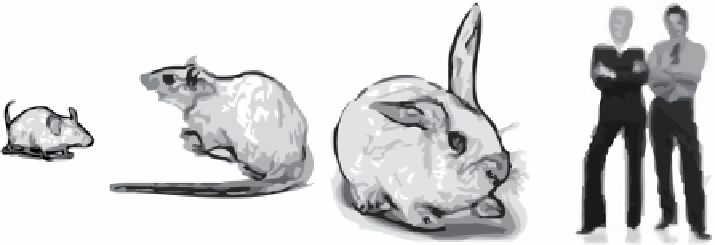Biomedical Engineering Reference
In-Depth Information
Human
(65-90 kg)
figure 16.1
Comparison of relative body weights for laboratory animals and humans for
dose estimation for preclinical imaging.
Mouse
(15-30 g)
Rat
(50-350 g)
Rabbit
(1-4 kg)
than 30 min as it produces heavy sedation to surgical plane of anesthesia and easy
positioning and manipulation without connection to hoses. Most injectable anesthetics
include controlled substances (ketamine, phenobarbital, etc.) requiring DEA licensing
and detailed record keeping. Injectable anesthesia is relatively nonreversible, has
a lower safety threshold, and is slower acting relative to isoflurane. on the other
hand, it is economical, requires no special equipment, and is relatively easy to use.
Formularies for injectable anesthesia regimens can be found in [5].
Inhalation anesthesia is used for many imaging procedures, particularly those
requiring more than 30 min. Isoflurane is administered via precision vaporizer in
100% oxygen. Anesthesia for small animals can be induced in an airtight chamber
prior to being placed in the imaging system equipped with nose cone for anesthesia
maintenance (Fig. 16.2). While isoflurane is not toxic, care must be taken to mini-
mize leakage of isoflurane vapor into the environment to protect personnel from
anesthetic effects.
16.3.4
temperature
It is important to maintain body temperature both for the health of the animal and
the quality of imaging results. It has been shown in many studies that body temper-
ature affects normal physiology and delivery of drugs and imaging agents within
the body of small animals. Due to the large surface area relative to weight of mice
and rats, they lose normal body temperature quickly. Anesthesia decreases the
body's ability to maintain normal body temperature. Thus, if external heat is not
supplied, animals can quickly become hypothermic, negatively affecting animal
health and reliability of experimental results. For example, hypothermia results in
constricted vasculature, decreased cellular metabolism, and poor lymphatic drain-
age. These factors can lead to decreased perfusion and nonspecific accumulation
relative to that seen in normothermic animals. Maintenance of body temperature
can be accomplished by two different methods: surface warming or heated air. The
method of choice is dependent on the imaging modality and the animal containment

Search WWH ::

Custom Search